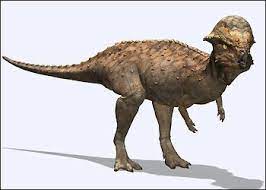
Prenocephale is a lesser-known dinosaur that inhabited Earth during the Late Cretaceous period, approximately 70 million years ago. This dinosaur is a member of the pachycephalosaur family, known for its distinctive domed skulls. Despite its somewhat obscure status, Prenocephale has contributed valuable insights into the diverse world of dinosaurs, especially in terms of their behavior, habitat, and the evolution of cranial structures.
Prenocephale was first discovered in Mongolia in the late 1940s and was named based on its unique cranial features. Its name means knob-headed in reference to the dome-shaped skull.
| Name: | Prenocephale dinosaurs |
| Size: | Around 6-7 feet in length. |
| Main Facts: | Prenocephale featured a prominent, domed skull and likely engaged in head-butting behavior, shedding light on dinosaur social dynamics. |
Prenocephale was a relatively small dinosaur, measuring about 6-7 feet in length and standing around 3 feet tall at the hip. Its most distinguishing feature was its thick, bony skull dome, which could have been used for head-butting during intraspecific competition, a behavior known as "doming."

Prenocephale's domed skull is a characteristic feature shared with other pachycephalosaurs. This feature has led scientists to speculate that these dinosaurs engaged in head-butting contests, possibly for social dominance or mating rights.
Prenocephale lived during the Late Cretaceous, a time when dinosaurs were diversifying and evolving various adaptations. It coexisted with a wide range of dinosaurs, including the iconic Triceratops and the ferocious Tyrannosaurus rex.
Fossils of Prenocephale have been found in Mongolia, contributing to our understanding of the distribution of pachycephalosaurs during the Late Cretaceous.
The possibility of head-butting contests among Prenocephale individuals suggests complex social behaviors within this dinosaur group. Studying these behaviors enhances our knowledge of dinosaur social structures.
Prenocephale's dome-shaped skull highlights the evolution of cranial structures in dinosaurs. Understanding the development of these features provides insights into their functions and adaptations.
Prenocephale was a small, herbivorous dinosaur from the Late Cretaceous, measuring around 6-7 feet in length and standing about 3 feet tall at the hip. Its most distinctive feature was its thick, domed skull, which likely played a role in head-butting contests during social interactions.
This dinosaur lived in Mongolia and was part of a diverse ecosystem that included other iconic Late Cretaceous dinosaurs like Triceratops and Tyrannosaurus rex. Prenocephale's skull structure offers insights into the evolution of cranial adaptations in dinosaurs and hints at complex social behaviors within its species.
Prenocephale shares typical pachycephalosaur features, including a thick, domed skull, which distinguishes it from other dinosaur groups.
Prenocephale was relatively small, about 6-7 feet in length, but its skull dome was a prominent feature. Comparing it to larger pachycephalosaurs like Stygimoloch and Dracorex shows variations in size within this dinosaur family.
The domed skull of Prenocephale suggests it engaged in head-butting behavior, possibly for social dominance or courtship rituals. Comparing this behavior with other pachycephalosaurs reveals variations in this intriguing aspect of dinosaur life.
Prenocephale, like all pachycephalosaurs, was herbivorous. Comparing their dietary preferences with other herbivorous dinosaurs highlights variations in plant consumption strategies during the Late Cretaceous.
Prenocephale lived during the Late Cretaceous alongside a diverse array of dinosaurs, including ceratopsians like Triceratops and theropods like Tyrannosaurus rex. Comparisons provide insights into the complex ecosystems of that time.
Fossils of Prenocephale have been found in Mongolia, while other pachycephalosaurs like Stygimoloch are known from North America. This geographical variation adds to our understanding of pachycephalosaur distribution.
Comparing Prenocephale's dome-shaped skull with other pachycephalosaurs showcases the diversity of cranial structures within this group and the potential functions of these adaptations.